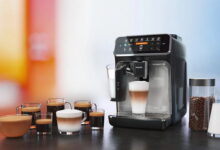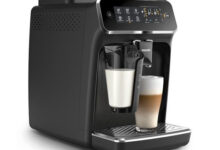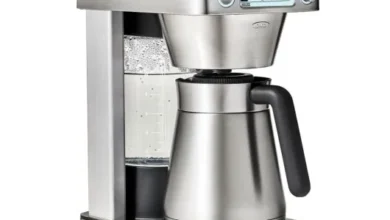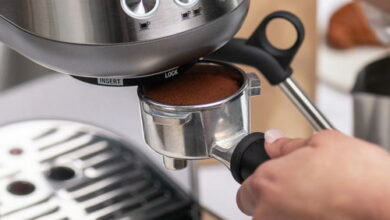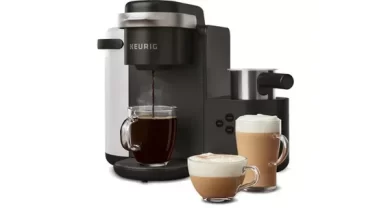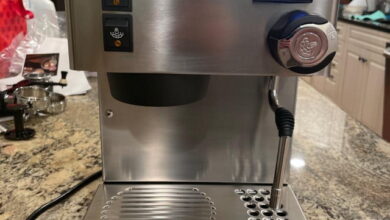When it comes to enjoying a cup of coffee at home, the quality of the machine you use can make all the difference. For coffee enthusiasts who crave convenience without compromising on taste, the Philips 5400 Fully Automatic Espresso Machine has emerged as a popular choice. With its advanced features and user-friendly design, this machine promises to deliver café-quality beverages with just the push of a button. In this comprehensive review, we’ll delve into the ins and outs of the Philips 5400, explore its key features, discuss its pros and cons, and compare it to similar models on the market.
Philips 5400 fully automatic espresso machine review—these are the words that often come up when coffee enthusiasts search for a machine that combines convenience with top-notch performance. The Philips 5400 is more than just a coffee maker; it’s a gateway to a world of café-quality beverages, right in the comfort of your own home. With its advanced features like the LatteGo milk system and a high-quality ceramic grinder, this machine promises to elevate your coffee experience, whether you’re craving a robust espresso or a creamy cappuccino. In this guide, we’ll dive deep into the capabilities of the Philips 5400, offering insights and tips to help you make the most of this impressive machine.
Philips 5400 Fully Automatic Espresso Machine Review
Overview of the Philips 5400
The Philips 5400 is a fully automatic espresso machine that aims to bring the café experience into your kitchen. Designed with ease of use in mind, this machine offers a wide range of coffee drinks at the touch of a button, making it ideal for both beginners and seasoned coffee lovers. With the ability to customize each drink to your preference, the Philips 5400 ensures that every cup is brewed to perfection.
One of the standout features of the Philips 5400 is its LatteGo milk system, which is designed to create silky smooth froth for your favorite milk-based drinks. Whether you’re in the mood for a cappuccino, latte, or flat white, the LatteGo system froths milk directly into your cup, eliminating the need for a separate milk container or frothing wand. This feature not only simplifies the brewing process but also makes cleanup a breeze.
The Philips 5400 also boasts a ceramic grinder with 12 adjustable settings, allowing you to tailor the grind size to your preferred taste. This ensures that the coffee is ground to the perfect consistency, whether you prefer a strong espresso or a milder brew. Additionally, the machine offers adjustable coffee strength, temperature, and volume settings, giving you complete control over every aspect of your coffee.
Key Features and Specifications
- LatteGo Milk System: The innovative LatteGo system is a highlight of the Philips 5400. It froths milk directly into your cup, creating a creamy, smooth texture with minimal effort. The two-part milk system is easy to clean and dishwasher-safe, making it a convenient option for daily use.
- Customizable Settings: The Philips 5400 offers a range of customizable settings, including coffee strength, temperature, and volume. With 12 grinder settings, you can choose the perfect grind size for your preferred coffee style.
- User-Friendly Interface: The machine features an intuitive touchscreen interface that makes it easy to navigate through the various options. The display is clear and responsive, allowing you to select your desired drink and customize it to your liking.
- High-Quality Ceramic Grinder: The ceramic grinder is designed to be durable and long-lasting, ensuring that your coffee beans are ground to perfection every time. The grinder is also quieter than many other models, making it a great option for early mornings.
- AquaClean Water Filter: The Philips 5400 comes with an AquaClean water filter, which helps to extend the life of the machine by reducing the need for descaling. The filter is designed to provide up to 5,000 cups of coffee before needing to be replaced.
- Compact Design: Despite its advanced features, the Philips 5400 has a compact design that fits easily on most kitchen countertops. The machine’s sleek appearance and modern aesthetic make it a stylish addition to any kitchen.
Pros and Cons
Pros:
- Ease of Use: The Philips 5400 is incredibly user-friendly, making it a great option for anyone who wants a hassle-free coffee-making experience. The touchscreen interface and customizable settings allow for effortless operation, even for those who are new to espresso machines.
- Versatility: With the ability to brew a wide range of coffee drinks, from espresso to cappuccino to flat white, the Philips 5400 is versatile enough to satisfy any coffee craving. The LatteGo system makes it especially easy to create milk-based beverages with minimal effort.
- Minimal Maintenance: The machine is designed with convenience in mind, from the easy-to-clean LatteGo system to the AquaClean water filter that reduces the need for descaling. These features make the Philips 5400 a low-maintenance option for daily use.
- High-Quality Build: The Philips 5400 is built to last, with durable materials and components that ensure long-term performance. The ceramic grinder is particularly noteworthy for its longevity and consistent grinding.
Cons:
- Price: The Philips 5400 is on the higher end of the price spectrum for home espresso machines, which may be a consideration for budget-conscious buyers. However, its advanced features and convenience justify the investment for many users.
- Limited Manual Control: While the Philips 5400 offers a high level of automation and customization, it may not be ideal for coffee purists who prefer manual control over every aspect of the brewing process. The machine’s automatic nature means that certain parameters, like extraction time, are not manually adjustable.
- Size: Although the Philips 5400 is compact compared to some other fully automatic machines, it still takes up a fair amount of counter space. Those with limited kitchen space may find it challenging to accommodate the machine.
User Experiences and Ratings
Overall, the Philips 5400 has received positive reviews from users, with many praising its ease of use, customizable settings, and the quality of the beverages it produces. The LatteGo system, in particular, has been highlighted as a standout feature, with users appreciating the convenience and quality of the milk froth. The machine’s build quality and design have also been well-received, with many noting that it feels sturdy and looks great on the countertop.
However, some users have pointed out that the machine can be a bit noisy during operation, particularly when grinding beans. Additionally, while the machine’s automation is a selling point for many, those who prefer more manual control over the brewing process may find it somewhat limiting. Despite these minor drawbacks, the Philips 5400 remains a popular choice for those seeking a high-quality, fully automatic espresso machine that delivers consistent results.
Philips 5400 LatteGo Troubleshooting Guide
Even the best espresso machines can occasionally run into issues, and the Philips 5400 is no exception. Fortunately, many common problems can be easily resolved with a bit of troubleshooting. In this section, we’ll explore some of the most common issues faced by Philips 5400 users and provide step-by-step solutions to get your machine back up and running smoothly.
Common Issues Faced by Philips 5400 Users
- Machine Not Turning On: One of the most common issues reported by users is that the machine fails to turn on. This can be frustrating, especially when you’re in need of a caffeine fix.
- Coffee Not Dispensing Properly: Another common problem is when the machine fails to dispense coffee, or when the coffee comes out too slowly or unevenly. This can be caused by a variety of factors, including clogs in the machine or issues with the grinder.
- Milk Frother Issues: The LatteGo system is designed to create perfect froth every time, but occasionally, users may experience issues such as the milk not frothing properly or the froth being too thin or watery.
- Water Leaks: Some users have reported water leaks from the machine, particularly around the water tank or drip tray. This can be caused by improper assembly or wear and tear on the machine’s components.
Step-by-Step Troubleshooting Tips
- Machine Not Turning On
- Check the Power Source: Ensure that the machine is properly plugged into a working outlet. If the machine is plugged in but still not turning on, try plugging it into a different outlet to rule out any issues with the power source.
- Reset the Machine: Sometimes, a simple reset can resolve the issue. Unplug the machine, wait for about 30 seconds, and then plug it back in. Try turning the machine on again.
- Check the Power Button: Ensure that the power button is not stuck or damaged. If the button feels unresponsive, it may need to be serviced or replaced.
- Contact Customer Support: If the machine still doesn’t turn on after trying these steps, it may be time to contact Philips customer support for further assistance.
- Coffee Not Dispensing Properly
- Check the Grind Size: If the coffee is coming out too slowly or not at all, the grind size may be too fine, causing the machine to clog. Try adjusting the grinder to a coarser setting and see if this improves the flow.
- Clean the Brew Group: The brew group may be clogged with coffee grounds, preventing the machine from dispensing properly. Remove the brew group, rinse it under warm water, and clean any buildup. Reinsert the brew group and try brewing again.
- Descale the Machine: Limescale buildup can also cause issues with coffee flow. Run a descaling cycle using a Philips-approved descaling solution to remove any buildup in the machine.
- Check the Coffee Puck: If the coffee puck is too wet or too dry, it may indicate an issue with the machine’s pressure. Adjust the coffee strength or grind size to achieve a more consistent puck.
- Milk Frother Issues
- Clean the LatteGo System: If the milk is not frothing properly, it may be due to a clog or buildup in the LatteGo system. Disassemble the two-part milk frother, rinse it under warm water, and clean any residue. Reassemble and try frothing again.
- Use Cold Milk: The quality of the froth can be affected by the temperature of the milk. For best results, use cold, fresh milk straight from the refrigerator.
- Check the Milk Type: Different types of milk (e.g., whole, skim, non-dairy) froth differently. Experiment with different milk types to find the one that works best with your machine.
- Water Leaks
- Check the Water Tank: Ensure that the water tank is properly seated and that the gasket is in good condition. If the gasket is damaged, it may need to be replaced.
- Inspect the Drip Tray: If water is leaking from the drip tray, check for cracks or damage. If the tray is damaged, it may need to be replaced.
- Tighten Loose Parts: Over time, parts of the machine may become loose, leading to leaks. Check the machine for any loose components and tighten them as needed.
When to Seek Professional Help
While many issues with the Philips 5400 can be resolved with simple troubleshooting, there are times when it’s best to seek professional help. If the machine continues to malfunction after trying the above steps, or if you notice any unusual noises, smells, or behaviors, it may be time to contact Philips customer support or take the machine to an authorized service center. Attempting to repair the machine yourself could void the warranty or cause further damage, so it’s important to rely on professional assistance when needed.
Philips 5400 Espresso Machine Milk Frother Replacement
For those who frequently enjoy milk-based coffee drinks like lattes and cappuccinos, the milk frother is an essential component of the Philips 5400 espresso machine. The LatteGo system, known for its ease of use and ability to produce silky smooth froth, is generally reliable. However, like any mechanical part, it may wear out or malfunction over time, requiring replacement. In this section, we’ll discuss the signs that indicate your milk frother may need to be replaced, how to replace it, and tips for maintaining the frother to extend its lifespan.
Signs That the Milk Frother Needs Replacement
- Inconsistent Froth Quality: If you notice that the froth produced by the machine is inconsistent—sometimes too thin, sometimes too airy—it could be a sign that the frother is wearing out. This inconsistency might be due to wear and tear in the frothing mechanism.
- Unusual Noises: Any unusual sounds coming from the frother during operation, such as grinding or whining noises, could indicate a mechanical issue. Over time, components inside the frother can wear down, leading to these noises.
- Frother Not Working at All: If the frother stops working entirely, refusing to froth milk or produce any foam, it’s a clear sign that something is wrong. This could be due to a blockage, damage to internal components, or a complete mechanical failure.
- Visible Damage: Inspect the frother regularly for any visible signs of damage, such as cracks or leaks in the milk container or spout. Physical damage is often a clear indication that the frother needs to be replaced.
Step-by-Step Guide to Replacing the Milk Frother
Replacing the milk frother on the Philips 5400 is a relatively straightforward process that most users can do on their own. Here’s a step-by-step guide to help you through it:
- Order a Replacement Frother: Before starting the replacement process, you’ll need to purchase a new LatteGo frother. Ensure you buy a genuine Philips part to guarantee compatibility and performance. These can be purchased directly from Philips or authorized retailers.
- Remove the Existing Frother:
- Ensure the machine is turned off and unplugged before starting.
- Detach the LatteGo system from the machine by lifting it out of its holder.
- Disassemble the two-part milk frother by separating the milk container from the spout.
- Install the New Frother:
- Attach the spout to the new milk container by aligning the notches and clicking them together.
- Place the assembled LatteGo system back into its holder on the machine, ensuring it’s securely attached.
- Test the New Frother:
- Plug the machine back in and turn it on.
- Run a milk-based beverage cycle, such as a cappuccino or latte, to test the new frother.
- Observe the quality of the froth and ensure that the machine is operating smoothly.
- Dispose of the Old Frother: If the old frother is damaged, dispose of it according to local recycling guidelines. Many parts of the frother, especially the plastic components, can be recycled.
Recommended Replacement Parts and Where to Buy Them
When it comes to replacement parts, it’s essential to use genuine Philips components to ensure your machine continues to operate at its best. You can find genuine LatteGo milk frothers through several sources:
- Philips Official Website: The most reliable place to purchase replacement parts is directly from Philips. The official website offers a range of accessories and replacement parts specifically designed for the Philips 5400.
- Authorized Retailers: Many online retailers, such as Amazon and specialty kitchen appliance stores, carry Philips replacement parts. Be sure to verify that the seller is authorized to ensure you’re getting genuine parts.
- Local Appliance Repair Shops: Some local appliance repair shops may also carry Philips parts or be able to order them for you. This option is particularly useful if you need the part quickly and don’t want to wait for shipping.
Maintenance Tips to Prolong the Life of the Milk Frother
To maximize the lifespan of your Philips 5400’s milk frother and ensure consistent performance, it’s essential to maintain it properly. Here are some tips:
- Regular Cleaning: After each use, disassemble the frother and rinse it thoroughly under warm water. This prevents milk residue from building up and clogging the frother. For a more thorough clean, both parts of the LatteGo system are dishwasher-safe.
- Use Fresh, Cold Milk: For the best froth quality, always use fresh, cold milk. This not only improves the frothing process but also reduces the chance of milk residue sticking to the frother’s components.
- Avoid Overfilling the Milk Container: Overfilling the milk container can cause milk to spill into the machine, leading to clogs or damage. Follow the fill line indicated on the container for optimal performance.
- Inspect Regularly for Wear and Tear: Regularly inspect the frother for any signs of wear, such as cracks or leaks. Addressing these issues early can prevent more significant problems down the line.
- Descale the Machine Regularly: Limescale buildup can affect the performance of your espresso machine, including the frother. Regular descaling helps maintain the machine’s overall health and ensures that the frother continues to operate smoothly.
How to Clean Philips 5400 Coffee Machine Properly
Proper maintenance of the Philips 5400 is crucial to ensuring its longevity and consistent performance. Cleaning the machine regularly not only enhances the flavor of your coffee but also prevents mechanical issues that can arise from residue buildup. In this section, we’ll provide a detailed guide on how to clean each part of your Philips 5400 coffee machine.
Importance of Regular Cleaning for Optimal Performance
Cleaning your coffee machine regularly is vital for several reasons. First, it ensures that your coffee tastes as fresh and flavorful as possible, free from the stale oils and residue that can accumulate over time. Second, regular cleaning helps to maintain the machine’s performance by preventing clogs and other mechanical issues. Finally, keeping your machine clean can extend its lifespan, protecting your investment in a high-quality espresso machine.
Detailed Cleaning Instructions for Different Parts of the Machine
- Brew Group:
- Weekly Cleaning: The brew group is the heart of your espresso machine and should be cleaned weekly. Remove the brew group from the machine (consult the user manual if needed), and rinse it under warm water. Be sure to remove any coffee residue that may have accumulated. Allow it to dry completely before reinserting it into the machine.
- Deep Cleaning: Every month, use a coffee oil remover tablet to deep clean the brew group. Follow the instructions on the tablet packaging to ensure thorough cleaning.
- Drip Tray:
- Daily Cleaning: The drip tray collects excess water and coffee residue, so it’s important to clean it daily. Simply remove the tray, empty it, and rinse it under warm water. Use a mild detergent if necessary, and make sure it’s completely dry before placing it back in the machine.
- Water Tank:
- Weekly Cleaning: The water tank should be cleaned weekly to prevent the buildup of mineral deposits and bacteria. Empty the tank and rinse it with warm water. Avoid using soap, as it can leave residue that affects the taste of your coffee. If you notice any mineral deposits, you can wipe them away with a cloth.
- AquaClean Filter: If you’re using the AquaClean filter, be sure to replace it as indicated by the machine (usually every three months) to keep your water clean and extend the time between descaling.
- Milk System:
- Daily Cleaning: The LatteGo milk system should be cleaned after every use. Disassemble the two parts and rinse them under warm water. For a more thorough clean, place both parts in the dishwasher. Regular cleaning prevents milk residue from clogging the system and ensures a smooth froth every time.
- Deep Cleaning: Once a week, soak the milk system parts in warm water with a bit of dish soap, then rinse thoroughly. This helps remove any milk fats or proteins that may have accumulated.
- Exterior:
- As Needed: Wipe down the exterior of the machine with a damp cloth as needed. Avoid using abrasive cleaners or scouring pads, as these can damage the machine’s finish.
Recommended Cleaning Products and Tools
- Philips Coffee Oil Remover Tablets: These tablets are designed specifically for cleaning the brew group and removing coffee oil residue that regular rinsing might not eliminate.
- Philips Descaling Solution: Use this solution every three to four months (or as indicated by the machine) to descale your machine and prevent limescale buildup.
- Dishwasher: The LatteGo system and drip tray are dishwasher-safe, making them easy to clean without any extra effort.
- Soft Cloth: Use a soft, damp cloth to wipe down the machine’s exterior and keep it looking new.
Tips to Prevent Buildup and Ensure Longevity
- Use Filtered Water: Using filtered water in your Philips 5400 can help reduce mineral buildup, which in turn reduces the frequency of descaling. It also ensures that your coffee tastes as pure as possible.
- Regular Descaling: Even with the AquaClean filter, it’s important to descale your machine regularly to prevent limescale buildup, which can affect the taste of your coffee and the performance of your machine.
- Avoid Overfilling the Grinder: To prevent the grinder from clogging, avoid overfilling it with coffee beans. Fill it just enough for a few days of use, and top it up as needed.
- Keep the Machine Dry: After cleaning any part of the machine, ensure it’s completely dry before reassembling. This prevents mold and bacteria from growing inside the machine.
Philips 5400 vs. Saeco PicoBaristo Comparison
When shopping for a fully automatic espresso machine, you’ll find several models competing for your attention. Two popular options are the Philips 5400 and the Saeco PicoBaristo. Both machines offer a range of features designed to simplify the coffee-making process while delivering high-quality beverages, but there are some key differences to consider. In this section, we’ll compare the Philips 5400 and the Saeco PicoBaristo across several categories to help you determine which machine is the best fit for your needs.
Overview of Both Machines
- Philips 5400: As discussed earlier, the Philips 5400 is known for its user-friendly design, customizable settings, and innovative LatteGo milk system. It’s designed for those who want a versatile machine that can handle a variety of coffee drinks with minimal effort.
- Saeco PicoBaristo: The Saeco PicoBaristo, another high-end fully automatic espresso machine, is known for its compact design and extensive customization options. It offers a slightly smaller footprint than the Philips 5400, making it a good choice for those with limited counter space.
Key Differences and Similarities
- Design and Build Quality:
- Philips 5400: The Philips 5400 features a modern, sleek design with a large touchscreen display. It’s slightly larger than the Saeco PicoBaristo, which may be a consideration for those with limited counter space. The build quality is robust, with durable materials that ensure long-term reliability.
- Saeco PicoBaristo: The Saeco PicoBaristo is more compact, making it easier to fit into smaller kitchens. It also features a stylish design, with a combination of metal and plastic components that feel solid and well-made. The machine’s smaller size doesn’t compromise on its functionality or durability.
- Coffee Customization Options:
- Philips 5400: With 12 grind settings, adjustable coffee strength, temperature, and volume, the Philips 5400 offers a high level of customization. The machine’s LatteGo system also allows for easy adjustment of milk froth levels, making it easy to create a variety of milk-based drinks.
- Saeco PicoBaristo: The Saeco PicoBaristo also offers extensive customization, with 10 grind settings and adjustable coffee strength and temperature. Additionally, it includes a bypass doser for pre-ground coffee, which the Philips 5400 lacks. This feature is useful for those who occasionally want to brew decaf or another type of coffee without emptying the bean hopper.
- Milk Frothing System:
- Philips 5400: The LatteGo system on the Philips 5400 is highly praised for its ease of use and consistent froth quality. It’s a two-part system that’s easy to clean and dishwasher-safe, making it a convenient choice for daily use.
- Saeco PicoBaristo: The Saeco PicoBaristo features a traditional milk frother, which provides more manual control over the frothing process. While it may require a bit more skill to use, some users prefer the manual frother for its ability to create custom textures.
- Price and Value for Money:
- Philips 5400: The Philips 5400 is positioned as a premium machine with a price to match. It offers excellent value for those who want a versatile, easy-to-use espresso machine with advanced features like the LatteGo system.
- Saeco PicoBaristo: The Saeco PicoBaristo is also a high-end machine, but it’s often priced slightly lower than the Philips 5400. It offers a great balance of features and performance, particularly for those who prefer a more compact machine with manual frothing capabilities.
Which Machine is Better for Different Types of Users
- Philips 5400: Ideal for users who value convenience and ease of use. The LatteGo system is perfect for those who frequently make milk-based drinks and want a hassle-free frothing experience. Its extensive customization options make it a great choice for users who want to experiment with different coffee styles without manual intervention.
- Saeco PicoBaristo: A better fit for users who have limited counter space or prefer a more compact machine. It’s also well-suited for those who enjoy having manual control over the milk frothing process. The bypass doser is an added bonus for users who like to switch between whole beans and pre-ground coffee.
Final Recommendation Based on User Needs
Both the Philips 5400 and the Saeco PicoBaristo are excellent machines that offer a range of features designed to elevate your home coffee experience. If you prioritize convenience, a sleek design, and an easy-to-clean milk system, the Philips 5400 is the better choice. However, if you prefer a more compact machine with manual frothing options and a slightly lower price point, the Saeco PicoBaristo might be the perfect fit for you.
Best Settings for Philips 5400 Espresso Machine
One of the key advantages of the Philips 5400 is its ability to customize every aspect of your coffee, from grind size to milk froth level. In this section, we’ll explore the best settings for different types of coffee drinks and offer tips on how to experiment with these settings to find your perfect cup.
Overview of Customizable Settings on the Philips 5400
The Philips 5400 offers several adjustable settings that allow you to fine-tune your coffee to your exact preferences:
- Coffee Strength: Choose from five different strength levels, ranging from mild to extra strong. This setting controls the amount of coffee used in each brew, affecting the intensity of the flavor.
- Grind Size: With 12 different grinder settings, you can adjust the fineness of the coffee grounds. Finer grounds are best for strong espressos, while coarser grounds are better suited for lighter drinks like Americano.
- Temperature: The machine allows you to adjust the temperature of the water used to brew your coffee. Higher temperatures extract more flavor, but can also lead to bitterness if overdone. Lower temperatures result in a smoother, less intense cup.
- Volume: Customize the amount of water used for each drink, from a short espresso shot to a large cup of coffee.
- Milk Froth Levels: The LatteGo system allows you to adjust the froth level for milk-based drinks. Choose from different levels depending on whether you prefer a thick, creamy froth or a lighter, airy texture.
Recommended Settings for Different Types of Coffee Drinks
- Espresso:
- Coffee Strength: Extra strong
- Grind Size: Fine (setting 2-3)
- Temperature: Medium-high
- Volume: 30-40 ml
- Milk Froth Level: None
Tip: For a more intense espresso, try reducing the volume slightly to concentrate the flavor.
- Cappuccino:
- Coffee Strength: Strong
- Grind Size: Medium-fine (setting 4-5)
- Temperature: Medium
- Volume: 60-80 ml
- Milk Froth Level: High
Tip: Use cold milk straight from the refrigerator for the best froth consistency.
- Latte:
- Coffee Strength: Medium
- Grind Size: Medium (setting 6-7)
- Temperature: Medium
- Volume: 100-120 ml
- Milk Froth Level: Medium
Tip: Experiment with the milk-to-coffee ratio to achieve your preferred balance of flavors.
- Americano:
- Coffee Strength: Mild
- Grind Size: Coarse (setting 10-12)
- Temperature: Medium-low
- Volume: 150-200 ml
- Milk Froth Level: None
Tip: For a smoother Americano, try lowering the temperature slightly to reduce bitterness.
- Flat White:
- Coffee Strength: Medium-strong
- Grind Size: Medium-fine (setting 5-6)
- Temperature: Medium-high
- Volume: 60-80 ml
- Milk Froth Level: Low
Tip: The flat white is all about balance, so aim for a silky microfoam with just a thin layer of froth.
How to Experiment with Settings to Find Your Perfect Cup
The Philips 5400 is designed to cater to a wide range of tastes, so don’t be afraid to experiment with different settings to find what works best for you. Here are some tips for tweaking your settings:
- Start with a Baseline: Use the recommended settings above as a starting point. Brew a cup using these settings, then adjust one parameter at a time to see how it affects the flavor and texture of your coffee.
- Adjust in Small Increments: When experimenting with grind size, coffee strength, or temperature, make adjustments in small increments. This allows you to fine-tune the flavor without making drastic changes.
- Take Notes: Keep a journal of your settings and the results. This will help you remember which combinations you liked best and make it easier to replicate them in the future.
- Taste Test: When you’re trying out new settings, brew a small amount first. This way, you can taste test without wasting too much coffee if the results aren’t to your liking.
- Experiment with Different Beans: Different coffee beans can have a significant impact on the flavor profile of your coffee. Try using beans from different regions, roasts, and processing methods to see how they interact with your machine’s settings.
Tips for Consistent Results
- Use Fresh Coffee Beans: Freshly roasted beans yield the best results. For consistency, try to use beans that have been roasted within the last two weeks.
- Store Beans Properly: Keep your coffee beans in an airtight container away from light, heat, and moisture. This helps preserve their freshness and flavor.
- Regularly Clean the Machine: A clean machine produces better coffee. Make sure to follow the cleaning instructions mentioned earlier to keep your Philips 5400 in top condition.
- Maintain the Grinder: Over time, coffee oils can build up in the grinder, affecting the grind consistency. Regularly clean the grinder as per the manufacturer’s instructions to ensure consistent grind size.
- Calibrate the Grinder: If you notice that your coffee isn’t extracting properly, it might be time to recalibrate the grinder. The user manual will provide instructions on how to do this.
Conclusion
The Philips 5400 Fully Automatic Espresso Machine is a versatile and user-friendly appliance that can elevate your home coffee experience. Whether you’re a seasoned coffee enthusiast or a beginner, this machine offers a range of customizable settings that allow you to create your perfect cup of coffee with ease. From its innovative LatteGo milk system to its high-quality ceramic grinder, the Philips 5400 is designed to deliver café-quality beverages at the touch of a button.
Philips 5400 fully automatic espresso machine review—by now, it’s clear that this machine is designed to meet the needs of both novice coffee drinkers and seasoned baristas alike. With its customizable settings and easy-to-use interface, the Philips 5400 ensures that every cup is tailored to your exact preferences. Whether you’re looking for the perfect frothy latte or a bold espresso, this machine delivers consistently excellent results. Investing in the Philips 5400 means not just owning a coffee maker, but bringing the full café experience into your home. With proper care and a bit of experimentation, you’ll find that this machine can satisfy even the most discerning coffee lovers.
With proper care and regular maintenance, this machine will serve you well for years to come, providing you with delicious coffee day after day. Whether you prefer a strong espresso, a creamy latte, or a smooth Americano, the Philips 5400 has you covered.
So, why not take the plunge and invest in a machine that brings the café to your kitchen? With the Philips 5400, your morning coffee routine will never be the same again.
FAQs about the Philips 5400 Fully Automatic Espresso Machine
- What types of coffee drinks can the Philips 5400 make?
- The Philips 5400 can brew a wide variety of coffee drinks, including espresso, cappuccino, latte, americano, flat white, and more. It also features the LatteGo milk system for creating smooth, frothy milk-based beverages.
- How do I clean the Philips 5400 espresso machine?
- The Philips 5400 features an easy-to-clean design with a removable brew group, drip tray, and LatteGo milk system. These parts can be rinsed under warm water, and some are dishwasher-safe. Regular descaling with the Philips descaling solution is also recommended.
- What is the LatteGo milk system, and how does it work?
- The LatteGo system is a two-part milk frothing system that creates silky smooth froth directly in your cup. It’s easy to assemble, clean, and is dishwasher-safe. It froths milk using high-speed steam and air mixing, making it perfect for lattes and cappuccinos.
- How can I adjust the coffee strength on the Philips 5400?
- The Philips 5400 allows you to adjust the coffee strength using its touchscreen interface. You can choose from five different strength levels to tailor the intensity of your coffee to your preference.
- Can I use pre-ground coffee with the Philips 5400?
- No, the Philips 5400 does not have a bypass doser for pre-ground coffee. It is designed to use whole coffee beans, which are ground fresh for each brew using the built-in ceramic grinder.
- How often do I need to descale the Philips 5400?
- The frequency of descaling depends on the hardness of your water and how often you use the machine. With the AquaClean filter installed, you can brew up to 5,000 cups before needing to descale. The machine will alert you when descaling is necessary.
- What should I do if the coffee isn’t hot enough?
- If your coffee isn’t hot enough, you can adjust the temperature settings on the Philips 5400. There are three temperature levels available, allowing you to customize the heat of your coffee.
- Is the Philips 5400 suitable for small kitchens?
- The Philips 5400 is relatively compact for a fully automatic espresso machine, but it does require some counter space. If your kitchen is very small, you may want to measure the available space to ensure the machine will fit comfortably.
- What kind of warranty does the Philips 5400 come with?
- The Philips 5400 typically comes with a standard two-year warranty. This covers defects in materials and workmanship. Be sure to register your machine after purchase to take full advantage of the warranty.
- Can I customize the grind size on the Philips 5400?
- Yes, the Philips 5400 features a ceramic grinder with 12 adjustable grind settings. This allows you to customize the grind size from fine to coarse, depending on your coffee preference.


